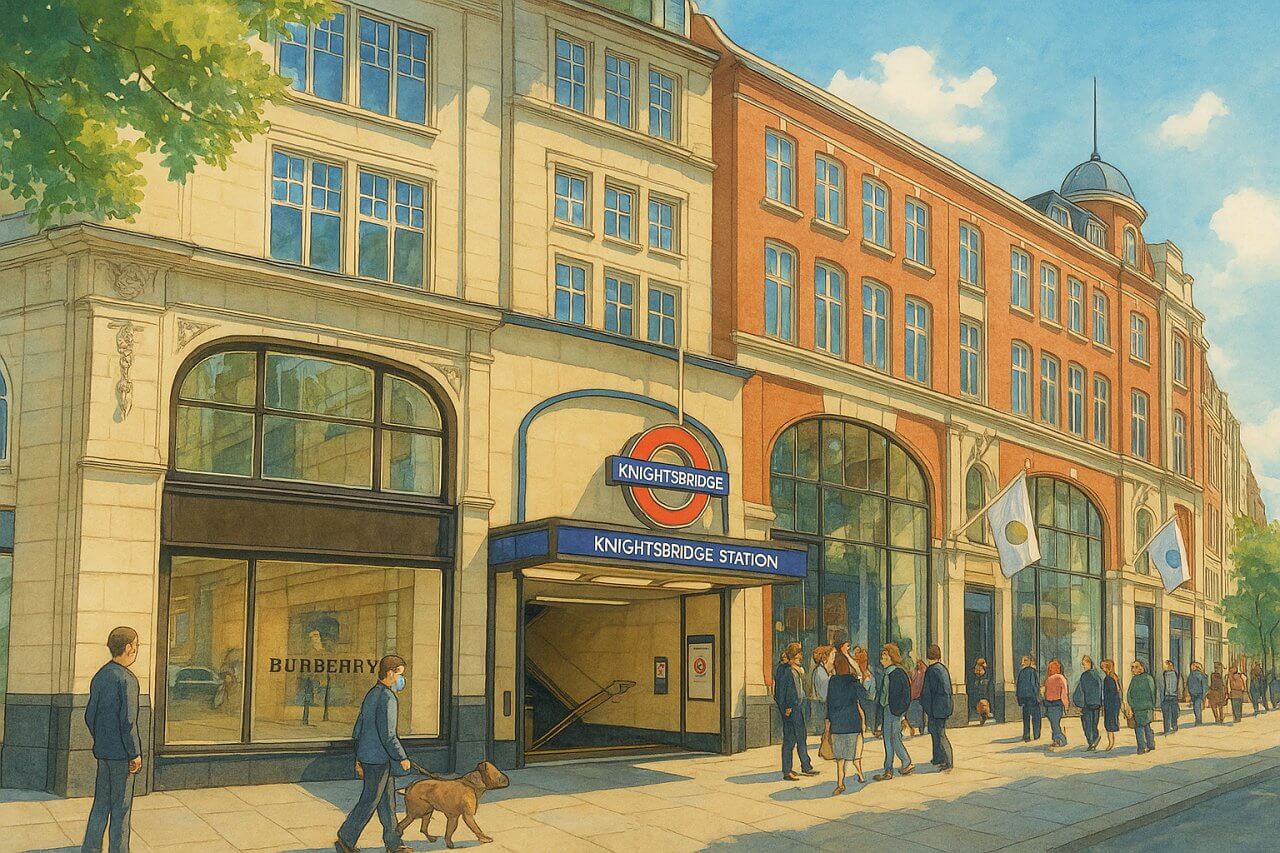
Knightsbridge Station, London
Knightsbridge Station (GPS: 51.50177, -0.16034) is a central London Underground station located in the affluent Knightsbridge district, on the Piccadilly line. It serves as a major access point to some of London's most prestigious landmarks, including Harrods department store, Hyde Park, and a number of high-end hotels and boutiques.
The station is situated in Fare Zone 1 and lies approximately 2.0 miles (3.2 km) west of Charing Cross by road. It is an important stop for shoppers, tourists, and locals commuting through the heart of the capital.
Station Entrances and Layout
Knightsbridge Station has multiple entrances situated on Brompton Road and Sloane Street. There is no single large ground-level station building; instead, the entrances are integrated into the urban streetscape, with some positioned within commercial buildings.
The original entrance was located at the junction of Brompton Road and Sloane Street, beneath what is now a retail space. In recent years, new entrances have been added, including a step-free access entrance on Hooper’s Court, part of the station’s modernization project.
Rail Services
Knightsbridge Station is served exclusively by the London Underground’s Piccadilly line. It does not provide Overground, National Rail, or other services.
Piccadilly Line
On the Piccadilly line, the station lies between:
- Hyde Park Corner (to the east)
- South Kensington (to the west)
The Piccadilly line offers direct connections to key destinations such as Piccadilly Circus, Covent Garden, King’s Cross St Pancras, and Heathrow Airport, making Knightsbridge Station a convenient entry point to both local attractions and long-distance travel.
History of the Station
Knightsbridge Station was opened on 15 December 1906 by the Great Northern, Piccadilly and Brompton Railway (GNP&BR), which later became part of the London Underground’s Piccadilly line. Like many of the original Piccadilly line stations, it was designed by architect Leslie Green, whose red glazed terracotta façades became iconic of early 20th-century tube stations.
The original station was equipped with lifts, as escalators were not yet in common use. However, in the early 1930s, the station underwent significant redevelopment to accommodate rising passenger numbers. Escalators replaced the original lifts, and a new ticket hall was created to provide better access.
Name and Origins
The station has always been called Knightsbridge, named after the surrounding area. The name itself originates from a bridge that once crossed the River Westbourne near the present-day Albert Gate. According to legend, the name “Knightsbridge” comes from a battle fought between knights at the bridge.
Modern Upgrades and Accessibility
In recent years, Knightsbridge Station has undergone substantial improvements as part of Transport for London’s initiative to modernize the Tube network. Notably, a new entrance on Hooper’s Court opened in 2022 with step-free access, making the station accessible to wheelchair users for the first time.
Two new lifts were installed as part of this project, improving the station’s usability for passengers with reduced mobility or heavy luggage—particularly useful given the station’s proximity to shopping destinations like Harrods.
Interesting Fact
A lesser-known fact is that Knightsbridge Station once had a disused extra platform. When the station was expanded in the 1930s, it briefly had four platforms to handle separate branches. However, the “Brompton Road” entrance and platform were soon deemed redundant and eventually closed off to the public.
Additionally, in 2004, Transport for London considered renaming the station “Knightsbridge-Harrods” due to its close proximity to the famous department store, but the proposal was ultimately dropped.
Nearby Attractions
Knightsbridge Station is ideally located for exploring some of London’s most luxurious and iconic destinations:
- Harrods: One of the world’s most famous department stores, located just across the street.
- Harvey Nichols: A luxury department store offering high-end fashion and food halls.
- Hyde Park: One of London’s Royal Parks, just a short walk away from the station entrance.
- Mandarin Oriental Hotel: A five-star hotel facing Hyde Park, popular with celebrities and dignitaries.
- Embassy of France: Located nearby in Knightsbridge, highlighting the international character of the area.
Conclusion
Knightsbridge Station serves as a key gateway to the stylish and historic district of Knightsbridge, connecting visitors and Londoners alike to luxury, culture, and green space. Its convenient location on the Piccadilly line and recent accessibility improvements ensure it remains an integral part of the London Underground network.
Quick Facts
- Lines served: Piccadilly line
- Fare Zone: Zone 1
- Opened: December 15, 1906
- Located on: Brompton Road and Sloane Street
- Entrances: Multiple entrances including at Brompton Road and Sloane Street
- Nearest stations: Hyde Park Corner (east), South Kensington (west)
- Distance from Charing Cross: Approximately 1.5 miles (2.4 km) by road
- Nearby sights: Harrods, Hyde Park, Mandarin Oriental Hotel, Harvey Nichols
References
- London Transport Museum: Knightsbridge Station Upgrade
- Transport for London – Knightsbridge Station Improvements
- Wikipedia: Knightsbridge Station
Knightsbridge Station is  on the Map of London Underground
on the Map of London Underground

Painting of Knightsbridge Station, London (View image in full size)